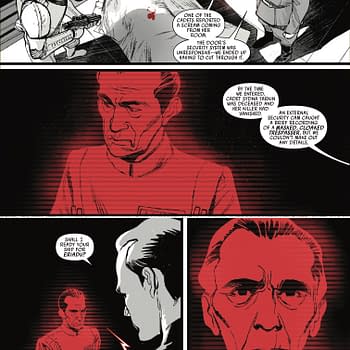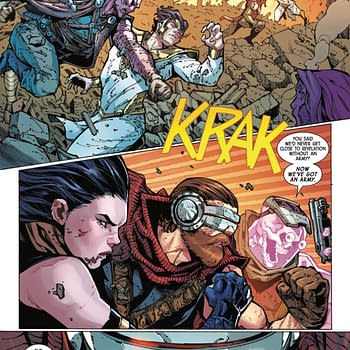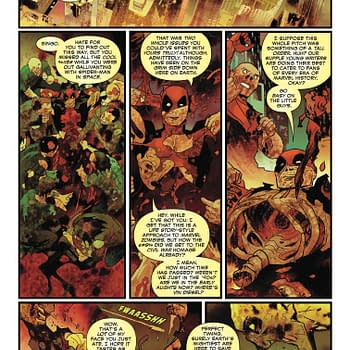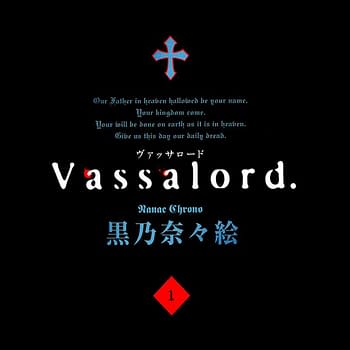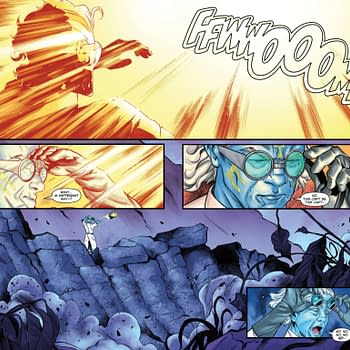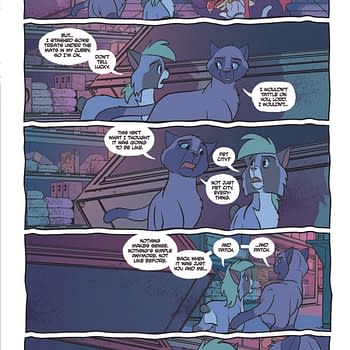Posted in: Comics, Recent Updates | Tagged: afterlife with archie, archie comics, buzzkill, dark horse, Grindhouse Doors Open At Midnight, hellboy in hell, image comics, letter 44, Locke & Key, Manifest Destiny, marvel, oni press, Red Circle Comics, sex criminals, superior spider-man, The Fox, The Wake, vertigo
Bleeding Cool's 11 Best Comics of 2013
By Rich Johnston and Hannah Means-Shannon
In case you haven't noticed, this is the first year in which Bleeding Cool has done "best of" lists, and there are many reasons for that. In the past, we've rightly acknowledged that to single out only a few comics for praise is to exclude others and with comics expanding into new genres every year, if not every month, it seems increasingly limiting to stand in judgment by using ranking systems. So why do it? Because we, as readers, make choices every day about what comics to buy and read in our limited amounts of free time, and to make recommendations to others is part and parcel of comics culture.
In fact, we rely on it. And because those who make comics thrive on observing innovation and draw inspiration from creative ingenuity. In case readers and creators somehow haven't noticed the strength of these comics, we have selected some we most recommend from 2013. To do this, we limited ourselves here to comics that have appeared in print single-issue form, whether in mini-series or ongoing series format, though they are also available digitally in the same creative units. These are Bleeding Cool's 11 best comics of 2013:
11. Sex Criminals, from Image Comics, written by Matt Fraction, with art by Chip Zdarsky
Generating buzz isn't enough to make a comic one of the top comics of the year, and though Sex Criminals certainly has done that with its semi-explicit depictions of sex and sexual themes like masturbation, there are three things that particularly make it a stand-out of 2013: Matt Fraction's relentlessly unpredictable and believable dialogue, often demystifying sex and one's private thoughts about sex, Chip Zdarsky's unique and unabashed indie style of linework and use of contrasting sharp and "fuzzy" definition, and the bold, even trend-setting cover art on the book. Some comics change the landscape of comics, and this book stands a good chance of doing that. It's like Sex Criminals tackled the elephant in the room and made it a showpiece, sexuality as a major part of human life rather than just a narrative ornament, and even managed to turn it into the focus of a hero story of sorts.
10. Buzzkill, from Dark Horse Comics, written by Donny Cates and Mark Reznicek, with art by Geoff Shaw and colors by Lauren Affe
Buzzkill is another comic that changes the conversation in comics and about comics without becoming a thinly disguised social treatise. In fact, it's hard to even type the phrase "social treatise" in connection with a comic that's so full of action, pulpy comic tradition, and weird science fiction elements. The fact that the series starts off handling the heavy themes of addiction and maintains them throughout while also lacing in equally dark themes of abusive relationships is fairly mind-boggling, and it couldn't succeed in its strange journey without the rabidly off-beat dialogue crafted by Cates and Reznicek and the rawly emotive, and at times even fragile linework that's setting Shaw apart as a comic artist to watch carefully in 2014. Sometimes a book seems to contain echoes of things to come for the creators involved, and all the parties on this comic have established the kind of innovation they are capable of. But read Buzzkill for the experience, always a page-turner, and splash around in Lauren Affe's intuitive and zany color-schemes.
9. The Fox, from Red Circle Comics, a division of Archie Comics, written by Mark Waid and Dean Haspiel, with art by Dean Haspiel
I don't think that anyone could have predicted that Red Circle Comics, and Archie Comics in general would have become the breakaway trendsetters of New York Comic Con in 2013, though those who were hearing rumors about The Fox and keeping their eye out for other Archie developments might have hoped, if not counted on that kind of sudden confluence of new approaches. The Fox is here in our "best of" list not because it sold out in its first issue very rapidly, nor because it looks so radically different from any other comic on the shelves this autumn, but because it represents something very rare in mainstream comics: a company giving what amounts to free reign to a strange idea passionately believed in by a creative team. A Silver Age hero revamped and given the energy rarely evidenced in "retro" properties that are often handled a little too sentimentally, the Fox combines many of the elements of a classic hero, but he faces a post-modern, often crippling rejection of a hero role. All this is handled lightly in Haspiel's non-stop motion style, making the book simply a pleasure to look at. And the storyline is blissfully unencumbered by that bane of resurrected properties: heavy self-awareness of its own place in comics history. For that reason, each panel of the book feels fresh and new. The colors buck the trend, too, and aren't even self-conscious enough to be called "hipster". They are a return to the sensibilities of Pop Art at its height and a celebration of the role of tone and hue as a key part of comic storytelling.
8. Grindhouse: Doors Open At Midnight, from Dark Horse Comics, written by Alex de Campi, with art by Chris Peterson, and Simon Fraser (with more artists to follow), colors by Nolan Woodward on issues #1 and #2, and cover art by Francesco Francavilla
This book has all the elements of a fabulously good terrible idea. The risks it takes in terms of reader reception are simply massive, and that makes its success that much more of a spectacle, in keeping with the spectacle-driven intentions of the series. Jumping between grindhouse cinema genres every two issues, the first two arcs, "Bee Vixens from Mars" and "Prisonship Antares" are now complete and confirm that the mini-arcs have a governing unity in their punchy attitude and brash handling of iconic sexual tropes while tackling science-fiction head-on. But as Bleeding Cool has suggested in the past, there's more to Grindhouse than meets the eye for the savvy reader–by bringing in elements of exploitation film, the comic says a lot about exploitation themes in comics and turns gender power-structures into stripped down basics in the hands of writer Alex de Campi. She divests these elements of domination and fear of the "other" of their taboo status and reinvents them as gender-universal tools of storytelling while still celebrating the kitsch and wacky playful attitudes of the grindhouse tradition. The result is an explosive comic, and one that will leave its mark as well as posing questions for the bolder members of the comics community to continue answering in 2o14 and beyond.
7. Verity Fair from idcm, written by Terry Wiley with art by Terry Wiley, colors by Terry Wiley, cover by Terry Wiley, everything by Terry Wiley.
It remains the comic book that simply not enough people have heard of. Hopefully its inclusion on the Sequential App might improve that, but Terry Wiley's continuance of his Sleaze Castle opus in a series that needs no previous knowledge whatsoever as we explore the life of an alcoholic semi-actress trying to get her life together, putting on a brave front, but falling apart in the small moments of the night, is clever, funny and looks drop dead gorgeous, as if Jeff Smith and Frank Quitely had bred, in terms of how a character appears on the page. This year has seen the character almost grow, trying to get her taxes, her acting career, her life sorted – but not quite. And with each issue, drawing from Love And Rockets, Tintin, Cerebus and Posy Simmonds, you just fall further in love with her. This is what Bridget Jones should have been and never was.
6. Superior Spider-Man, from Marvel Comics, written by Dan Slott, with art by Ryan Stegman
Love it or hate it, Superior Spider-Man has continued to be one of the most ground-breaking mainstream hero comics of 2013. Other comics have toyed with the superhero-supervillain reversal in the past, but none have pursued it so relentlessly into emotion-rending territory as this wholesale relocation of a villain's mind into a hero's life. It's the definitive bull in a china shop scenario as Doc Ock toys with the persuasive power of environment over personality, and swings between the allure of being beloved and the desire for asserting the power that will make him either a hero or a villain. And for poor Peter Parker, consistently rendered powerless with only his quips for company, things become more tragic than even a Spider-Man story usually shoulders. What started as an interesting idea that engages with some of the deeply-rooted flaws in superhero tradition turns into a marathon interrogation of superhero comics in Superior Spider-Man, all while maintaining a wide cast of characters and reminding us consistently of the fragility of Spider-Man's world. Still surprising this far along in the series is the fact that a book like this happened at all, since it chips away and tinkers with the structure of the very long-lived superhero properties that support the Big Two.
5. Letter 44, from Oni Press, written by Charles Soule, with art by Alberto Jimenez Albuquerque and colors by Guy Major
The debut of the year, Charles Soule and Raphael Alburquerque delivering a stunning bolt from the blue in terms somewhere between The West Wing and 2001: A Space Odyssey. A defense for the actions of President Bush (if this kind of thing was actually going on), its a procedural drama for First Contact that eschews the formulaic and gives us the petty, pragmatic detail on what such an event might involve. It grabs the reader and places them in the front seat that complicitly involves them in making the same choices that the new President has to.
And you do. Charles Soule is writing a lot of books right now. This is, by far, his best.
4. The Wake, from Vertigo, a division of DC Comics, written by Scott Snyder, with art by Sean Murphy
The Wake follows its own star as a series, shuffling aside expectations and even the burdens of science-fiction and horror traditions in comics, and for that reason it swims rather than sinks. Neither Scott Snyder nor Sean Murphy, for all their massive successes as comics creators in other works really gave any preliminary signs that they were capable of producing something so far outside of their previous oeuvres, making the series that much more remarkable. That is, in fact, the definition of a phenomenon, however, The Wake has proven that it's in it for the long haul. Rather than relying on the simple sticking power of a series of unusual ideas about the origin of humanity and the menaces of a deep-sea race of beings, and encouraging the suspense that Murphy is more than capable of generating in his panel layouts, The Wake embraces the long game in comics and in that way actually resists the overly-decompressed graphic novel collection planning typical these days. Though planning has certainly gone into the series, more than readers at first realize, the comic flows like a long-running series that focuses on texture and detail issue by issue. The Wake is a strange beast, and one that refuses to give up the best features of serialized comic storytelling or the certainty that, all told, it will complete one narrative. And it does all that while keeping you on the edge of your seat. Let's hope Snyder and Murphy remember that trusting their instincts for the weird and profound can yield great things in future projects.
3. Hellboy in Hell, from Dark Horse Comics, written by Mike Mignola, with art by Mike Mignola and colors by Dave Stewart
Hellboy has, over time, become a grand old man of comics, which is perhaps as much a surprise to his creator Mike Mignola as it would be to the character himself. But what do you do when you've created, and allowed others to help create, a universe so complex that its inner workings become as much a part of the plot as the character-driven storyline a particular comics universe is known for? You take it all away, and you return your central character to a man vs. nature scenario. In this case, of course, it's demon vs. Hell as befits the nature of the being and his own natural environment. The Hellboy in Hell storyline continues to be both episodic in fan-delighting detail and epic in hero-journey scale that for many readers, they might be content for it to simply go on forever. That is a feat rarely accomplished in comics, and owes as much to Mignola's hard-headed obsession with staying true to character as his relentless craftsmanship of haunting panels capable of standing alone as examples of a high-point in comic art. Hellboy in Hell, in particular, is an arc where nothing particular happens and yet everything happens, trapped somewhere in Hellboy's patchy memory of dark deeds. For a series that has resisted psychological revelations about the titular character, Hellboy in Hell suggests the fragmentation of a hero's psyche, a loss of identity, and yet refuses to allow the reader to "abandon all hope". For a comic with an often meandering pace, it continues to await rather patiently other works that might attempt to catch up to all its accomplishments.
2. Locke & Key, from IDW, written by Joe Hill, with art by Gabriel Rodriguez, colors by Jay Fotos, and letters by Robbie Robins
Locke & Key could easily rank in one of the best comics of the past five years, but since we're only working with 2013 here, that will have to be praise enough somehow. Like many of the comics in this list, it's the product of a strange confluence between the kind of stories a couple of supremely talented people are internally driven to tell. It's hard to imagine that Joe Hill would have produced such startling concepts in quite so flamboyant a fashion were he not egged on by Gabriel Rodriguez' upping the ante consistently on how to express supernatural themes visually and psychological realities in such sensory-engaging terms. It would be remiss not to include Jay Fotos color work on the series in this visionary company because the tone of the comic is so firmly established by the tension between a certain physicality in flesh-tones and the strangely blurred lines between the gradations of perception and reality. Fotos in many ways is the artist who makes us "believe" in the world of Locke & Key so firmly, though that's not to take away from the heights of imagination Rodriguez routinely reaches in each issue. Selecting the series as one of our top comics of 2013 is not a lament for its conclusion, but a reminder that a tightly conceived series that nevertheless allows room for its own growth in storytelling techniques can maintain massive readership over time. It's a testament to the strengths of the comic art form when it is handled in a way that includes the reader as a participating factor, reminding us that in many ways, comics are all about the experience of the page.
1. Afterlife with Archie, from Archie Comics, written by Roberto Aguirre-Sacasa, with art by Francesco Francavilla
Who would have thought there would be one, let alone two Archie books in the top eleven of the year? And this is written from the perspective of someone who actively dislikes standard Archie titles. But the complete reinvention of Riverdale as a teen horror is incredibly convincing as it takes America's favorite icons and transforms them into either zombies, or those who would kill their old zombied friends. Again, the reader, who may also regard them as friends, is complicit in that decision. Whether it's Sabrina The Teenage Witch getting hold of the Necronomicon, two established young girls of Riverdale expressing their love for one another, or the slow transformation of Archie into a man who has to do what must be done, this comic surprised everyone who came across it. For the better. I do hope other all-ages publishers take note…
Honorable mentions to Manifest Destiny, All New X-Men, Superman Unchained, Crossed: Wish You Were Here, The True Lives of the Fabulous Killjoys, Thunder Brother: Soap Division, Demeter, Saga, Quantum and Woody, Umbral, Trillium, Federal Bureau of Physics, Sandman: Overture, and Coffin Hill.





















